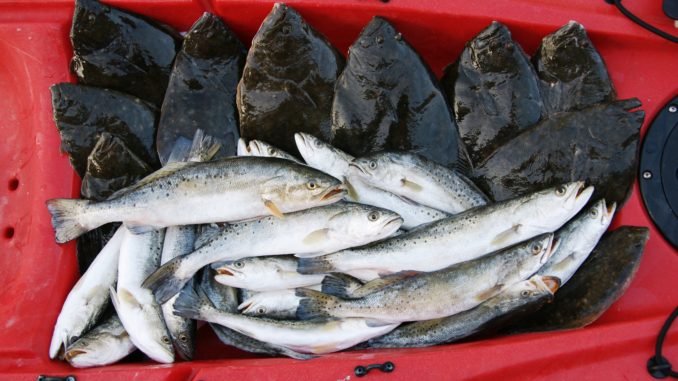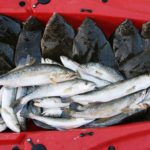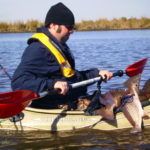
Season offers some excellent action
Wintertime fishing in South Louisiana can be fantastic. The cold weather brings less fishing pressure and concentrates the fish in many areas that are easily accessible to kayak anglers. However, a change in fishing techniques and safety gear is necessary to ensure not only a productive but safe fishing trip.
No fish is worth dying for, and kayak anglers are much more susceptible to the dangers associated with fishing in cold weather. Kayaks offer no protection from brutally cold winter winds, and by the boats’ nature, you will get wet. Being exposed to cold wind and water are the two main causes of hypothermia, which can cause serious health risks, including death.
The normal human internal body temperature is 98.6 degrees. When that temperature is lowered, even only a few degrees, hypothermia can set in and cause a slow-down of life-critical body processes. Kayak fishing in cold weather can easily lead to hypothermia. Basic actions such as the normal dripping of water off your paddle, which feels refreshing in the summer, can lead to serious health complications while kayak fishing in the winter.
The good news is that with proper precautions and clothing, you can safely kayak fish even in the dead of winter. The two main words to remember to prevent the loss of body heat are windproof and waterproof. By keeping the wind and water off your body, you will maintain your core body warmth.
Getting wet from the outside is not the only concern. Paddling/pedaling a kayak is a strenuous activity that can cause you to perspire. Layered, loose clothing with a basegarment that wicks moisture away from the skin is a necessity. Build successive layers as necessary to account for the day’s temperature changes. Today’s modern fabrics are specifically engineered to keep you warm and dry. A waterproof stuff-bag can be used to store clothing so you can add/remove layers as needed.
The final outer layers should be both waterproof and windproof. A good choice for your lower body is a pair of light-weight, breathable waders. A wader belt cinched tightly at chest level alleviates any concerns of the waders filling with water in the event of an unfortunate submersion. Top this off with a good wind and waterproof jacket or rain parka.
Necessary accessories include waterproof gloves, socks and wading boots. A lot of body heat that would otherwise be contained in your clothing will be lost if you leave your head and neck uncovered. Top off your outfit with a warm hat and a neck gaiter.
The proper clothing and accessories will help ensure a safe outing when kayak fishing on cold days. However, additional precautions should be taken to prepare for a completely safe outing. Even though kayakers generally don’t travel far from their launch site, these sites are often in more remote locations that may be difficult to locate if a rescue effort is necessary. Prepare a float plan and make sure someone knows the general area you where you will be fishing. This can narrow the search area and save precious extra time in the event of an emergency.
Although a good idea for any season, a survival kit stored in your kayak is essential for wintertime fishing. As noted above, hypothermia is the biggest danger faced when fishing in cold weather. The basics included in the kit should be a solar blanket and a fire starter (waterproof matches, butane lighter, flint/striker, etc), which can be used to provide life-saving warmth. The kit should also include a flashlight, first-aid supplies and a marine radio. High-protein snacks such as beef jerky, trail mix or energy bars and some water should also be included.
Now that you’ve prepared for the worst, let’s experience the best. Wintertime fishing can provide fantastic action. The biggest rule to remember is to slow down the presentation of your bait. The general rule of thumb is to work the bait as slowly as you can — and then slow it down some more. The bites will often be very subtle, and anytime you feel the slightest difference in your line you should set the hook.
When the water temperatures drop, both trout and redfish will congregate in deeper areas, and limits can often be caught without moving from spot to spot. In these conditions, slowly work live, Carolina-rigged cocahoes or tightlined plastics up from the middle of deep bayous or dead-end canals.
A bright winter sun can quickly warm shallow areas by radiating heat to the dark sediment bottoms. As the day wears on, even a change of only a few degrees in water temperature can move the fish up to nearby ledges and flats. Fish the grass edges and cuts along the shore with a plastic shrimp or Cocahoe about 2 feet under a popping cork.
Kayaks are perfect for drift fishing, which is a very productive wintertime method. The slightest wind will slowly push the kayak across a lake or bay while tight-lining a plastic bait or using a popping cork. You will usually pick up a few fish on each drift, and can quietly paddle back to where you started and repeat. If the wind is moving the kayak too quickly, a small drift sock can be used to slow and better position your drift.
The northwest winds associated with winter cold fronts will lower the water in most coastal areas. This is another advantage to kayak fishing, and you will be able to access many areas that powerboat fishermen cannot. Also, the low water will expose oyster reefs and other bottom structure that is usually not seen. Make note of these features as they will likely be productive areas for your spring and summer fishing.
When winter’s cold blows in, there’s no reason to put away your kayak. By using sensible precautions and the proper equipment, you can safely continue to fish throughout the winter months. Adapt your fishing techniques and gear to account for the cold, and you can have a fantastic day of kayak fishing.
Hypothermia Facts
-Your body heat will drop quickly if you are wet or exposed to cold wind.
-Tight clothing hinders circulation and can contribute to hypothermia.
-Dress appropriately, and stay warm and dry.
-Conserve energy. Exhaustion leads to a quicker onset of hypothermia.
-Symptoms of hypothermia are confused speech, sleepiness and disorientation.
-Shivering is your body’s attempt to generate heat and ward off hypothermia.
-Alcohol, caffeine and tobacco will exacerbate hypothermia and should never be used if you will be exposed to winter elements.
-Treat the symptoms of hypothermia with dry clothing, a warm fire, warm liquids (no coffee, tea or alcohol) and high-energy foods.
-Seek appropriate medical attention as soon as possible.




